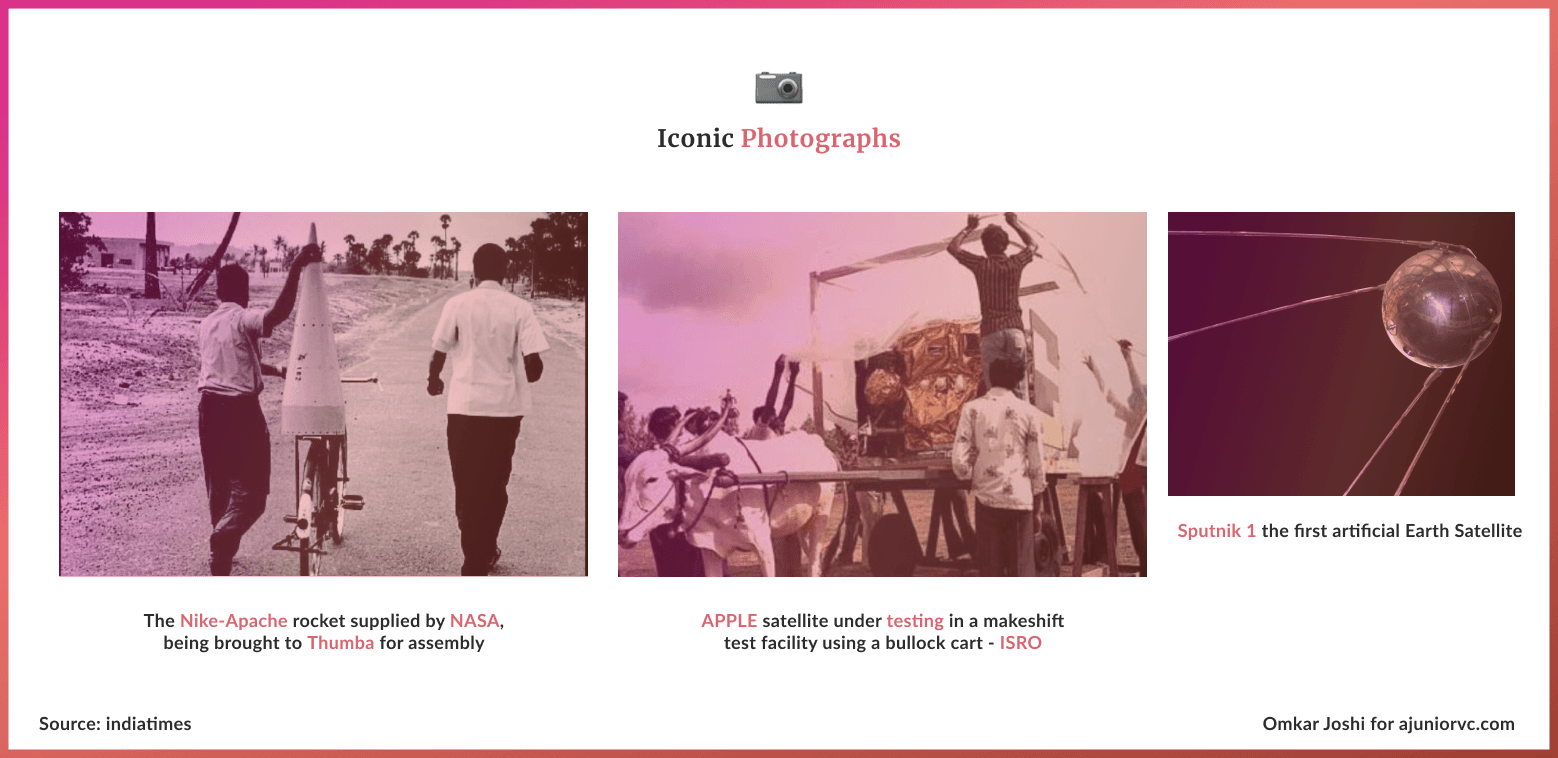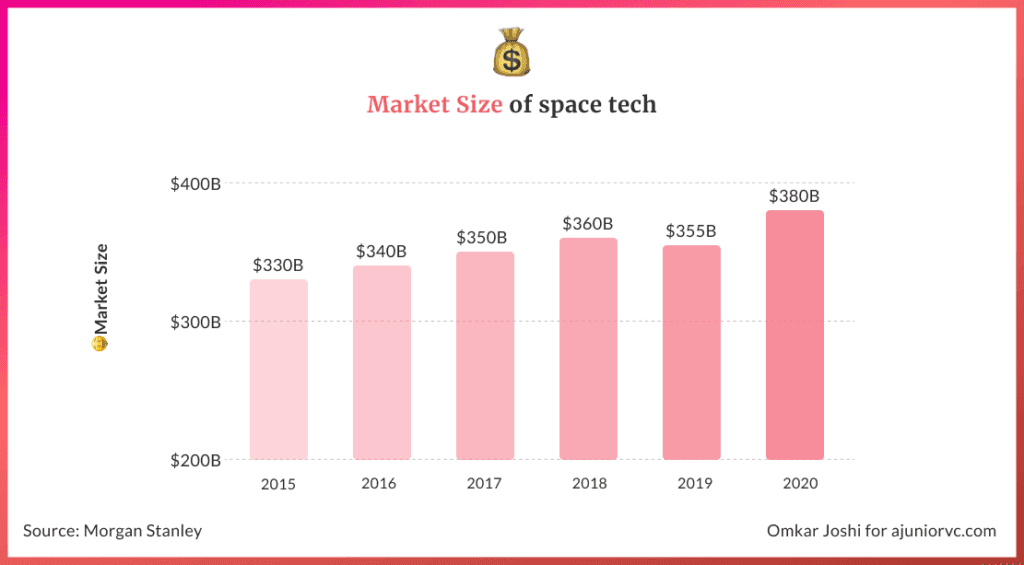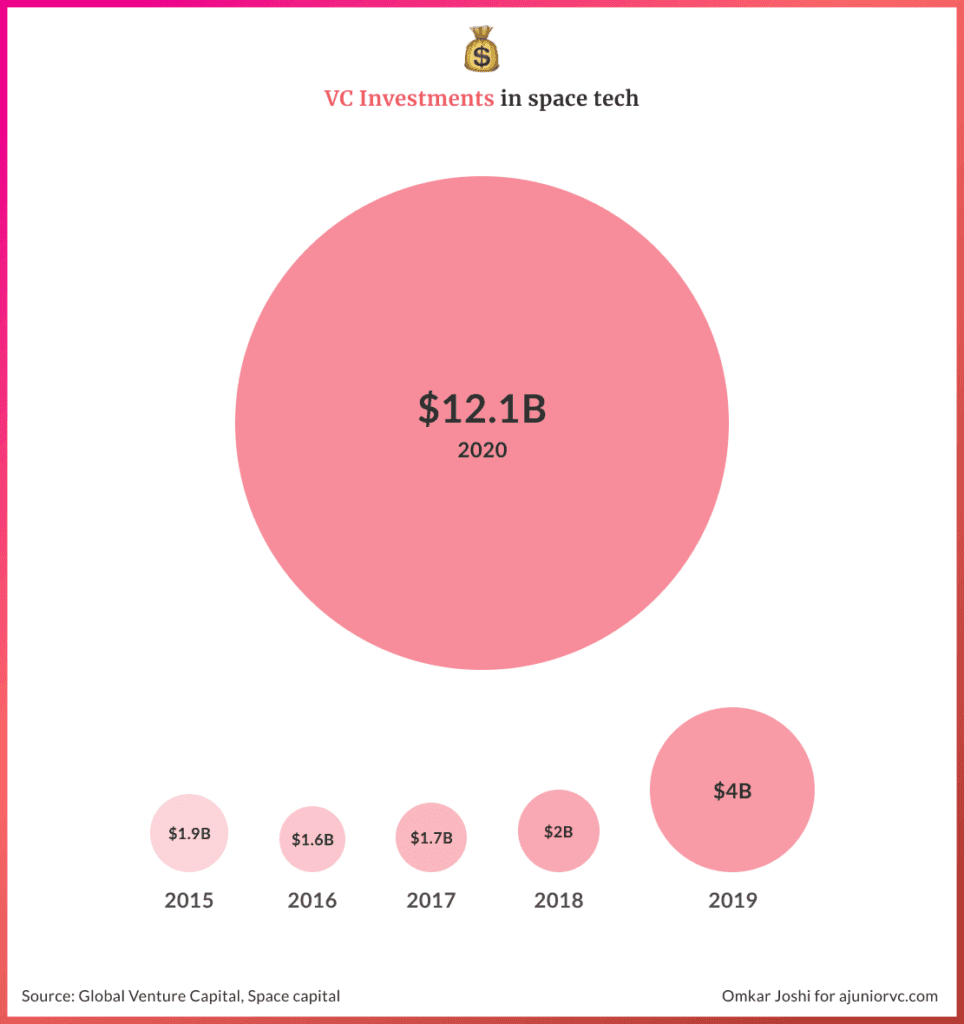
Sep 6, 2020
Is India Space Tech's Dark Horse?
Deep Tech
IPO
B2B
Technology
Last fortnight commercial space pioneer SpaceX finished its record breaking 180th launch in a single month, along with Indian Space Tech upstart Pixxel raising $5MM.
Winning Cold Star Wars
In the cold Russian winter of 1957, Sergei Korolev was labouring away with his team.
Cooped in a top secret Soviet lab to be the first to put a man made object in space, Sergei and his team were racing against time. The cold war was intensifying between the two superpowers of the world, the USA and the Soviet Union.
On October 4, 1957, at exactly 2228 hours 34 seconds Moscow Time, Sergei would see his dreams come to reality with the Soviet satellite, Sputnik 1, becoming the first artificial object put into orbit.
Although the iconic Sputnik looked like a beach ball and weighed only 83kg, it kindled the curiosity of three billion minds, and for the first time, we weren’t pointing at countries or continents, we became aware of the earth.
A few thousand kilometres away, in the Indian city of Ahmedabad, a man named Vikram Sarabhai was keenly observing the success of the Soviets.
He recognised that a country as demographically large as India would require its own independent space capabilities and that this would be crucial to the progress of the nation.
In 1962, Sarabhai’s vision for Indian space would propel him to become the chairman of the newly established Indian National Committee for Space Research (INCOSPAR) under the Department of Atomic Energy.
Sarabhai would convince a few young enthusiastic scientists trained at the National Aeronautics & Space Administration of the US, to come back to India to help with India’s space mission.
He wanted to start off by launching lightweight rockets that go up to a height of 100 km, to study a phenomenon called the equatorial jet.
To do this, he would go on to establish the Thumba Equatorial Rocket Launching Station (TERLS) in 1963 at the most unlikely of places.
Thumba, a fishing village in Kerala about 25 km from Thiruvananthapuram would be the place India would begin aiming for the stars.
A New Hope
The 1.5 sq km of Thumba was acquired in 100 days flat.
The local church became the control room, the bishop's house became the office and a bicycle became the ferry. As a bonus, each scientist got their own personal lab, a cowshed.
Far from the government funded and sponsored space programs of the US and USSR, India was building for space in frugality. It would get ingrained into the way India built for space.
Naked eyes were used to track the smoke plume from rockets. The only means of transportation of equipment were an old jeep, cows and a manually operated crane.
It is in this unlikely setting that India’s soaring vision of harnessing space technology took shape.
The Americans scoffed at the Indian men hustling away in cowsheds, literally.

The Americans believed that there were food shortages in India and the US was giving India grain. How could a country which couldn’t even feed itself start building rockets and satellites?
They did not think that India would be able to develop the technology needed to do something so complex.
It looked like the Indian space mission was set to fail with its limited funding and resources.
Rockets took off before the actual time for launch, some took off horizontally without even being fired and some did not reach the required heights.
However, after three years of failures, Sarabhai and his band of young scientists finally proved everyone wrong with a successful sounding-rocket launch.
The men continued to launch sounding-rockets of greater size and complexity, until the space programme was expanded and eventually given its own government department, independent of the Department of Atomic Energy.
While Armstrong completed his victory lap after landing on the moon, Indian men were making the first steps towards space.
On August 15th 1969 the Indian Space Research Organisation (ISRO) was created from the INCOSPAR programme under the DAE, continued under the Space Commission.
As India was quietly building, the space race was going to see one player disintegrating.
The USSR Empire Doesn’t Strike Back
Sergei Korolev would be both the pioneer and void in catapulting the USSR program
It was Sergei Korolev’s untimely death in due to complications from colon cancer which proved to be USSR’s undoing in the space race which they were leading up till that point.
While he was alive, Korolev fended off attempted meddling from designers like Mikhail Yangel, Vladimir Chhelomei, and Valentin Glushko. But the power vacuum that arose after his demise proved catastrophic.
The death of Korolev, and the mishaps under his successors, are the real reason why the Soviets lost their lead in the space race, and never achieved the goal of landing humans on the Moon.
Smaller goals, such as the first robotic rover on the Moon, as well as the first uncrewed landings on Mars and Venus, were achieved by the Soviet space program in the 1970s, but the big prize was already taken.
If not for Korolev's unexpected health decline and death, perhaps history would have turned out differently.
Another communist nation, albeit poorer than the USSR, launched 返回式卫星 (Fanshui Shi Weixing) in 1975, a one-off but high intent launch.
The other space power, the US, which was going from strength to strength after the Apollo program.
With a man having landed on the moon, they setup Skylab in 1971 the first space station and potentially a place for human colonization. They launched the space shuttle in the 1980s, which would become the iconic space photograph.
Inspired by the American space program, Japan began to launch its own rockets. Perhaps as a signal of their technological superiority, between 1985 and 1992, the Japanese conquered both space and the moon through unmanned aerial vehicles.
Canada, the UK, Spain and Sweden would also throw their hats into the ring, but none would come close to succeeding like the space giants.
India, though, had other more pragmatic plans.
Practical Interstellar Explorations
Dr Sarabhai had taken a very different approach to space, unlike the two global superpowers fighting for visibility.
He believed that Indians would build for use cases with actual use to India, versus having fantasies about landing on the moon. This pragmatism would result in very focused building, another pillar in India’s outlook to space.
Satellites would become what Indians wanted to build.
Indian scientists, politicians and industrialists were recognising the potential of satellites in the fields of remote sensing and communication.
ISRO studied the feasibility of using satellites for applications as wide as direct television broadcasting & weather forecasting found that it made economic sense. Satellites would accrue benefits to India from the moment go.
For a country where more than 2/3rds of the population depends on agriculture, predicting the weather, rain, floods and droughts could mean the difference between a thriving and a starving population.
They worked on creating independent launch vehicles, capable of launching into orbit and providing the valuable experience needed for the construction of larger launch vehicles in future.
Recognizing the advanced capability India had in building solid motors with the Rohini series, and that other nations had favoured solid rockets for similar projects, the ISRO set about building the technology and infrastructure for the Satellite Launch Vehicle (SLV).
The SLV was ready to be launched from a newly-established second launch site, the Satish Dhawan Space Centre (SDSC). The first launch in 1979 was a failure, attributed to a control failure in the second stage.
Failures would also happen globally, showing how truly hard rocket science is.
Colombia crashed in Apr 1981, the shaft structure reached their design limits due to the overpressure. Five years later, unusually cold temperatures led to the loss of the Challenger.
The learnings from failures in the 80s would result in safer spaceflight in the 90s.
The first indigenous satellite launched by India was called Rohini-1. It was not until 1992 that the first successful launch of the Augmented Satellite Launch Vehicle (ASLV) took place.
At this point the launch vehicle, which could only put very small payloads into orbit, had achieved its objective.
While India launched its first indigenous satellite, the Soviet Union disintegrated. The USSR would leave one indelible impact on space, the ISS. It may have happened only because the powers realized that there was only one true power remaining.
In 1993 the time had come for the maiden flight of the Polar Satellite Launch Vehicle (PSLV). The first launch was a failure. The first successful launch took place in 1994, and since then, the PSLV has become the workhorse launch vehicle.
This placed both remote sensing and communications satellites into orbit, creating the largest cluster in the world, and providing unique data to Indian industry and agriculture.
Around that time, under pressure post disintegration, Glavkosmos halted the transfer of the associated manufacturing and design technology to India.
Until then, ISRO had not been affected by technology transfer restrictions thanks to the political foresight of Sarabhai in indigenizing technology.
The vision was always to make India self-reliant using space technology. It would entail making India self-reliant in using space technology and not depending on Russia and the US for providing all the necessary components.
As political pressure kept increasing, the scientists at ISRO worked hard to develop an indigenous cryogenic engine. This would prove to be crucial in India’s first lunar mission.
Around the turn of the century, heralding the nuclear test feat at Pokhran, former Prime Minister Atal Bihari Vajpayee gave the slogan “Jai kisan, Jai Jawan, Jai Vigyaan” and inspired millions to dream about becoming rocket scientists.
But as we entered the new decade, there was another serious player emerging on the scene.
China and India See the “Space Between Us”
China’s one off launch of the Fanshui Shi Weixing may have been it's quiet trigger.
The origins of the space program of China can be traced to the 1950's when it launched a ballistic missile program to counter the perceived threats from the US and Soviet Union.
It was however five decades later that China successfully launched its first human space flight mission in Oct 2003. The success of Shenzhou 5 made China the third country after the US and Russia to send humans to space.
In the absence of the USSR and NASA having not done anything substantial in the 90s except the ISS, there was another space race brewing.
The players this time were India and China.
While China took a route of national rhetoric and patriotism, India still stuck to its pragmatic roots. While either side denied the existence of any such race, there were unmissable signs of another geopolitical dance.
Vajpayee urged Indian scientists to build, soon after the 2003 Chinese mission. India launched its first successful lunar probe, Chandrayaan, five years later in October 2008. It would become the first lunar probe to find water on the Moon.
The Indians had pulled one up, and the Chinese would follow.
3 years later, China would send its own lunar probe. It would soon follow up with a lunar rover being sent in 2013, the first by an Asian country and the first of the new century.
But India would have the ace in the pack which would take everyone by surprise, inspiring millions in the audacity and frugality of its attempt.
In the same month of China’s lunar landing, India launched a Mars Orbiter Mission. As we all know, this Mars Mission was called Mangalyaan.
A year later, Mangalyaan would reach Mars and succeed. In what would be a success of epic proportions, the mission would cost $70MM, 1/10th of the NASA mission, a feat that is yet to be beaten. As many memes would note, it was cheaper than an auto.
India would be the third country after the US and the USSR to do it. The space community was stunned and India had planted its flag in the race.
As India and China played the tango, more disruptive winds of change were blowing through the industry.
Elon’s Deep Impact
A Hawthorne based company was making waves, led by a maverick founder.
SpaceX had just become the first private player to send a spacecraft to the International Space Station. Dragon had done it in 2012, and it was setting the pace for the rest of the world.
Just after India’s epic Mars Mission, SpaceX would complete the first propulsive landing for an orbital rocket, or deconstructructed for us humans, a vertical take off and landing. The feat would propel SpaceX to the league of legends.
The impact of this would be significant. Space till then had been the vanguard of government space agencies. SpaceX’s audacious attempt to build would open the floodgates for private companies.
Another tech billionaire who had been dreaming of space would have his company ramp up.
Blue Origin would begin to compete with SpaceX, with sub-orbital flights. Blue Origin would become Bezos’ vehicle to fulfill a childhood dream and push the envelope further for humanity.
The duopoly of SpaceX and Blue Origin would mirror the duopoly’s of the space race, which would also inspire countless others to think about space.
While NASA awarded contracts to SpaceX, and Blue Origin began to play its cards, Virgin Galactic decided to focus on space tourism.
In 2017, SpaceX would go one step further by utilizing a reusable rocket. The implications of this were massive for the industry.
The cost of building a rocket is enormously high, upwards of $100MM. The cost of launching a kilogram into space till the mid 2000s was $20K, and it could never be used again. In a commercial flight, that cost is less than $5.

SpaceX reduced that cost to $2K per kilogram. It was the Moore’s Law moment for space.
Allowing to effectively reuse a rocket would crash costs, and open the game up for other players. The high barriers to entry in space were not only due to the high technical barriers, but also the prohibitive costs involved.
At around the same time, India would launch PSLV-37. While it may appear to be a routine launch, the rocket would put a mind boggling 104 satellites into space. This would be 3x of the next best of 34.
India was showing all the markers of a dark horse in a category that was heating up. ISRO and SpaceX were showing it was possible to build frugally for space.
Even with the high costs involved, space was beginning to look like a gold mine.
Beating Space’s Costly Gravity

Space is expected to grow from $350B today to more than $1T in the next two decades.
Investors remain bullish on the sector, which has the potential to generate as much economic value as the internet. Spacetech is at a nascent stage of investing for VC’s globally but innovative startups with unique models have started coming up following the beat of the pioneers.

Massive value will be unlocked in spacetech stacks such as GPS, communications, geospatial intelligence, analysis, distribution and management of data collected by existing space-based infra and space-based observation.
In fact, GPS has delivered the largest venture outcomes in history and generated trillions of dollars of economic value.
Beyond the torchbearers of the industry such as SpaceX, Blue Origin there are 500+ smaller companies which are heralding the privatization of space.
It is not hard to see why that is.
Space tech is the building block of innovation. Space missions are a great way to visibly demonstrate a nation's advancement in science and engineering as seen through the earlier sections
Many technologies, which we take for granted, such as wireless headsets, camera phones, CAT scans, electrolytic water purifiers owe their origin due to the Apollo mission to the moon.
The decades of building has resulted in the breakthrough of launching and operating small satellites.
This has democratized access to space and opened up fascinating possibilities for new lines of business. Cost of access to space has decreased 10x over the past 10 years and will further go down buoyed by new technologies such as miniaturization, reusable rockets, new materials etc.

As you realize the possibilities, the current innovation in spacetech looks a lot like a tsunami.
While it might appear far and as a mere speck, in the coming years the momentum can unleash a wave of disruption that can go far beyond the space sector itself.
Startups are hungry to fill the gap here.
A Startup Ad Astra
The variety of businesses around space have led to diverse start-ups.
The majority of space technologies are relatively nascent. Firms offering a variety of services have been from the United States due to the technological advancements and investors' support in taking one of humanity's longest strides yet.
In the privatization of space, the Russians have taken a strange approach – to enable advertisements from space. Start Rocket is into Orbital billboards, a.k.a marketing from the orbit.
Historically speaking, there would have been just another country giving stiff competition to the United States – The Russians. But times have changed, and so have aspirations.
With all the satellites, rockets, space exploration and the sheer amount of data available - Tradeinspace from the UK believes in the democratization of data generation and analytics in space.
For prolonged space exploration, the manufacturing of space components is essential for the economies of scale. China being a manufacturing powerhouse of the last three decades, has start-ups in the satellite manufacturing and launch sectors with Onespace and ZeroG Technologies
Missions like OneWeb and Starlink have plans to provide internet to inaccessible areas for Earth from Space.
Now with all the satellites and rockets in space, the exploration is already crowded, and in decades, may increase exponentially. With over 128 million debris in space and orbit, the Japanese start-ups - Astroscale focuses on cleansing of space and orbits by removal of the debris from the orbits.
But the key innovation that could be a game changer are the reusable rockets.
As Morgan Stanley puts it best, the elevator was an innovation that enabled the building of buildings that nobody saw, reusable rockets could be like the elevator to space.
The coming of high commutation power, decrease in cost to launch to the lower orbit by over 90%, application of reusable rockets, and a near-perfect landing of the reusable rockets from the Earth.
The buzz around space technologies is similar to the buzz around the internet in the 1960s and 1970s, just that this might be quicker with the advancements of complementing deep technologies and business models, and purpose that revolves around future space exploration.
The internet established a eureka moment in the history of humankind.
It connected the industrialization 3.0 and 4.0. Similarly, space exploration can make one of the science-fiction movies or books into reality.
The majority of the existing companies have invested heavily in building the space infrastructure to enable prospective firms to use their services to sync for space explorations; it's about time that space travel becomes more accessible and affordable for a common man - just as the internet became.
The success of the internet was because we are building on the shoulders of giants. All the infrastructure that was created to build the internet, such as by the pioneering DARPA, were the foundations to build internet companies.
There is no better person to talk about the impact of the internet than Jeff Bezos, and his assessment of space as the Internet is illuminating in this absolutely riveting conversation.
As Bezos elaborates, just as the internet grew, other industries adopted and adapted to it. Space technology promises for a similar adoption and will grow multiple industries along with it.
With multiple countries now engaging in private space markets, this is indeed a clarion call for the next generational deep-technologies to emerge from not just the powerhouses of the world, but also the rising sun.
India has all the ingredients to be space’s dark horse.
2021: An Indian Space Odyssey
Sarabhai’s legacy established India as a pragmatic, and not a profligate space force.
The immediate future of space will not be in colonization, i.e. sending humans to space, but in improving the experience on Earth i.e. satellites and learnings from space. This is primarily because it is just extremely costly to do the first.
As Sarabhai’s prescient observation plays out, ISRO and Indian companies will benefit. ISRO has, famously, never overshot its budget, and continues to see more investments.
Technically, India continues to be superior.
One of ISRO's most ambitious missions, Chandrayaan-2 lander Vikram just missed the landing by 400 meters to create history. India would have been the first country in the world to land on the south pole of the moon in search of the trillion-dollar nuclear fuel on the moon.
India also holds the record for launching the lightest satellite ever - STUDSAT-1, a picosatellite weighing only 950 grams (34 oz); this was made by students belonging to a space education firm. The capacity to synergize economical, technological, and scalable space missions is a powerful weapon that India holds and could well be witnessed in the decades to come.
ISRO also has a commercial arm under Astrix Corporation Limited, which is responsible for managing projects with other nations.
In the private start-ups front - the manufacturing of components is an opportunity for India. Start-ups like Agnikul and Bellatrix focus on economic microsatellites. India could capitalize on the tremendous technological front with the support of ISRO and well be the manufacturer for the world in economic microsatellite and nano-satellites.
An area where India could do incredibly well is space-as-a-service.
Kawa space and Pixxel are building data generation and space analytics infrastructure. Importantly, they are building a space-as-a-service solution for the existing industries like Climate, Urban monitoring, Forestry and Agriculture for the Earth from space.
The opportunities for India to commercialize are enormous. Transporting from Earth to orbit to space via affordable reusable rockets at subsidized cost could be India's homerun given ISRO's experience and the start-ups' desire for service capabilities.
Ceteris paribus, space transportation-as-a-service, creates opportunities for frequent payload deliveries to the international space station, human transportation, and transportation for exploration purposes like mining and planetary odyssey.
With multiple organizations around the world building the infrastructure for space, this is less of colonization and more about collaborative community building in space. To keep momentum incessant, constant services are essential.
India has been a pioneer in providing solutions with economies of scale for the world, and this is no different. With constant technological advancements, India could well be providing a variety of space services in the decades to come.
A highly skilled group of technically talented individuals, with a hungry entrepreneurial spirit puts India in good stead. As Sagan’s famous blue dot shows, space is vast and we are all just a speck in it.

As Collins said, "It's human nature to stretch, to go, to see, to understand. Exploration is not a choice, really; it's imperative." Indian companies, startups and government agencies are pushing the envelope.
In a rare category where Indian talent is both technically superior and cost efficient, India is space technology’s dark horse.
By: Aviral, Chetan, Keshav, Rohan, Shreyans
Visuals: Omkar
Audio Version: Behind the Scenes with AJVC
As usual, we have done a behind the scenes format with the writers and host Mazin